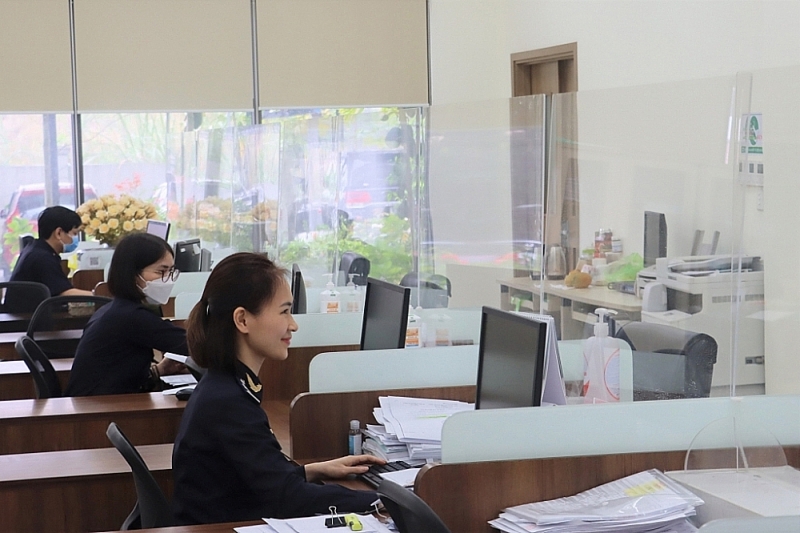 |
| Professional activities at Hon Gai Port Customs Branch, Quang Ninh Customs Department. Photo: Quang Hung |
Building a prestigious and elite team
The Plan on Reform, Development and Modernization of the Customs sector to 2025 (according to Decision No. 1855/QD-BTC dated September 13, 2022 of the Ministry of Finance) clearly indicated solutions and implementation organization in the organization of the apparatus and human resources.
In which, building the organization of the 3-level Customs apparatus – the General Department level, the regional level and the Sub-department level. At the same time, research and renovate the organization and operation of specialized units in analyzing and determining key points according to each type of border gate; goods classification unit; price management unit, goods origin; customs dossier inspection unit; consolidating the organization of the customs inspection apparatus to implement the project on reforming the model of quality inspection and food safety inspection for imported goods according to Decision No. 38/QD-TTg.
In addition, building and developing a contingent of Customs officers at all levels with professional qualifications, integrity, professional working style, master modern technology and equipment, sufficient in terms of quantity, suitable structure, meeting the modern customs management model.
The contingent of civil servants at the Strategy level are qualified, capable, reputable and meet the requirements of the task in the new situation; building and developing a team of professional experts at the levels of General Department and Regional Customs.
Developing and implementing public and transparent human resource recruitment mechanism with reasonable remuneration to ensure the attraction of high-quality human resources for the Customs sector; building and implementing the model of human resource management according to capacity based on job position; building an electronic human resource management system to ensure maximum automation of human resource management procedures.
Building modern facilities, training management methods to the standards of regional training institutions and a team of lecturers specialized in customs knowledge, pedagogical skills, a number of full-time lecturers, and part-time lecturers recognized by the World Customs Organization (WCO) as lecturers that can participate in international teaching.
Research and apply modern training methods, advanced technologies in professional training and retraining Customs officers, civil servants and officials. Building a rotation model for training and retraining among all levels, between departments in the same unit, in each professional field, among professional fields; and enhance customs integrity.
Streamlined organization, reducing intermediary focal points
Implementing the Plan of Reform, Development and Modernization of the Customs sector up to 2025, recently, the General Department of Customs issued Decision No. 2158/QD-TCHQ dated October 3, 2022 on the assignment of tasks to units under and directly under the General Department of Customs to effectively implement assigned tasks.
According to this Decision, the General Department of Customs assigns the Department of Personnel and Organization to preside over and coordinate with other units in the sector to complete the organizational structure, functions and tasks of the General Department of Customs through reporting to the Ministry of Finance for submission to the Prime Minister for promulgating a Decision to replace Decision No. 65/2015/QD-TTg defining the functions, tasks, powers and organizational structure of the General Department of Customs directly under the Ministry of Finance.
Accordingly, on the basis of reviewing the organizational apparatus, functions, tasks, and payroll to report to the Ministry of Finance for submission to the Prime Minister for promulgating a Decision replacing Decision No. 65/2015/QD-TTg.
Next is to implement the Decision to replace Decision No. 65/2015/QD-TTg, review and arrange the organizational structure of departments, agencies and units directly under the General Department of Customs in a streamlined direction, reduce intermediary focal points, not overlapping in functions and tasks, ensure effective and efficient operation and meet management requirements according to a smart customs operation model.
Accordingly, reviewing the organizational apparatus, functions, tasks, and payroll of units under and directly under the General Department of Customs; study the digital customs operation model, smart customs, the development orientation of the Customs sector, the Party and State’s orientation on organizational structure.
On that basis, it is proposed that each customs department of the province or city establish a centralized customs clearance sub-department to receive centralized customs declarations through the system; Customs branches under provincial/municipal Customs Departments carry out customs supervision and physical inspection of goods, along with reviewing and rearranging customs offices, post-customs clearance inspection sub-departments, the Customs Control Team and the Anti-drug Control Team in a lean-oriented direction, meeting the requirements of digital and smart customs models.
On the other hand, research and renovate the organization and operation of specialized units in analyzing and determining key points according to each type of border gate (land, sea, air, river, railway); goods classification unit, price management unit, goods origin; customs dossier inspection unit. Consolidating the organizational apparatus of the customs inspection to implement the Project on Reforming the model of quality inspection, food safety inspection for imported goods.
Completing and enhancing the quality of lecturers in the Customs sector. Accordingly, supplementing the force and improving the quality of the core lecturers at Vietnam Customs University ensure that each lecturer has full practical experience and in-depth knowledge of at least one specialized professional customs field. At the same time, supplementing and enhancing the quality of part-time lecturers to ensure sufficient pedagogical knowledge and soft skills in teaching, etc.
